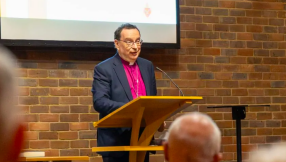Today is St Patrick's Day, when all around the world people with Irish roots – and plenty of others who just like to party – celebrate the life of the fifth-century saint. There are parades with floats and banners, Guinness consumption doubles, and there is even the odd church service.
Ah, St Patrick – who could be more Irish than that?
Pretty much anyone, actually. Whisper this, but Patrick was actually a Brit, captured by Irish pirates and sold into slavery. After six years he escaped and went home.
There must be more to it than that.
Oh, all right. During his enslavement he became a Christian. After his escape he saw a vision in which he was called to return to Ireland as a missionary. He probably landed at Wicklow, at the same port from which he had earlier escaped, but the natives were unfriendly and he was forced further north. He was energetic, innovative and fearless, becoming the first bishop of Armagh and Primate of Ireland.
I seem to recall something about snakes and shamrocks.
Both of these are Patrick stories, though there is a good deal more to say about him, as we shall see. The story is that there are no snakes in Ireland, because Patrick banished them all. Allegedly he used the shamrock as a sermon illustration for people who found it hard to grasp the idea of the Trinity: there's one shamrock but it has three leaves.
When you say that he banished snakes...?
Of course he didn't. That is what is known as an aetiological story, a myth generated to explain an observed fact. There are no snakes in Ireland because they didn't survive the last ice age. However, the story might have developed because snakes were associated with paganism, and it symbolises Patrick's victory over non-Christian religions.
And the shamrock?
Almost as improbable, unfortunately: the first reference to it is on a coin from 1675 showing the saint holding one, but the link to the Trinity isn't spelt out until 1726. On the other hand it's not a bad illustration and perhaps he really did use it.
This is rather depressing. Can we at least be sure he actually existed?
Oddly enough, given that this was a time when attitudes to history were a little more relaxed than they are now, we can. There are two letters that are generally accepted to have been written by him, the 'Confessio' or 'Declaration' which contains most of the details of his life, and the 'Letter to the Soldiers of Coroticus'. There are plenty of other stories, but like the snakes and shamrocks, they should be taken with a very large pinch of salt. Furthermore, in a positive embarrassment of riches, there may have been two of him: some of the stories told about him in later years might actually have been about an earlier missionary, Palladius. Patrick himself died in 460 AD, or possibly 493.
Nothing's ever simple, is it?
Not when you're talking about the Dark Ages, it isn't. This was the tail end of Roman rule in Britain, not long before King Arthur may or may not have lived. Be grateful.
A little more about Patrick, then?
In his Confessio, Patrick writes that he baptised thousands of people, ordained priests to lead the new churches and converted many women, some of whom became nuns. He also converted the sons of kings. He did not introduce Christianity to Ireland, but he was a major player in its spread, not least because of his evident organisational skills. However, it was not all plain sailing. He refused to accept gifts from kings because he wanted to remain unfettered by loyalties to particular tribes and clans. Consequently, he was vulnerable to attack, writing that he was on one occasion beaten, robbed and chained. On another occasion he was held captive for 60 days.
And apart from his own writings, what do we know?
'Know' is putting it a bit strongly, but there are two books from the late seventh century that have survived, both based on a lost earlier work, the Book of Ultan. One is by Tírechán and one, the Vita Sancti Patricii, by Muirchu moccu Machtheni. They show him as someone who contests with druids and overthrows pagan idols, and also stress his work with royal and noble women.
This is all very commendable, but is it too frivolous to ask for some more colourful stories?
Not at all. One legend said that his walking stick grew into a living tree, for instance: he thrust it into the ground whenever he was preaching and on one occasion spoke for so long that it took root. This story has the whiff of a tale told by a disgruntled hearer with things to do; the modern equivalent would be the person who closes the Bible audibly at 11.25 am and glares at the preacher until he stops. Another tells of how he met two ancient warriors, Caílte mac Rónáin and Oisín, legendary members of Fionn mac Cumhaill's warrior band the Fianna, and discussed the relative merits of Christianity and paganism with them. The National Museum of Ireland in Dublin has St Patrick's Bell, first mentioned in 522 and removed from his tomb 60 years after his death to be used as a relic. He may well have written the original words for the hymn sung today as 'St Patrick's Breastplate', beginning: "I bind unto myself today the strong name of the Trinity."
He certainly seems to be worth remembering.
Indeed. Christianity took root in these islands a long time ago, but the early saints and martyrs were true heroes and heroines. They had to make a Middle Eastern faith understandable to northerners whose presuppositions were very different. They had to know when to compromise on inessentials and when to stand firm, how to talk to poor people and kings, and in the face of every imaginable vested interest, how to make the new religion more attractive than the old. This was arguably the first example in history of cross-cultural mission. Nowadays people go to college before they try it; they had to learn as they went along. They made lots of mistakes, but the fact that we are here today shows that in the main they succeeded.
Most of all, they had to know how to die: it was always a risk, and many of them did.
Happy St Patrick's Day.
Cheers.













